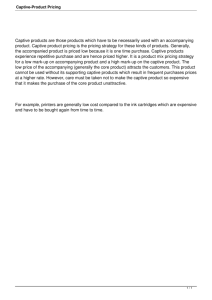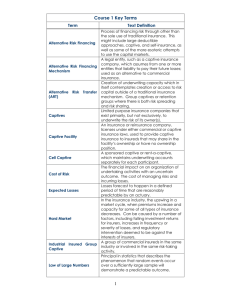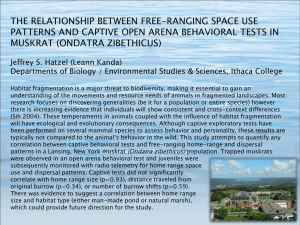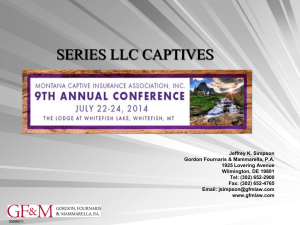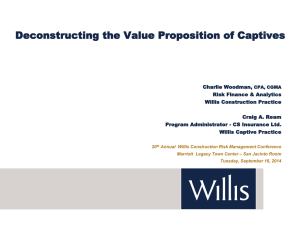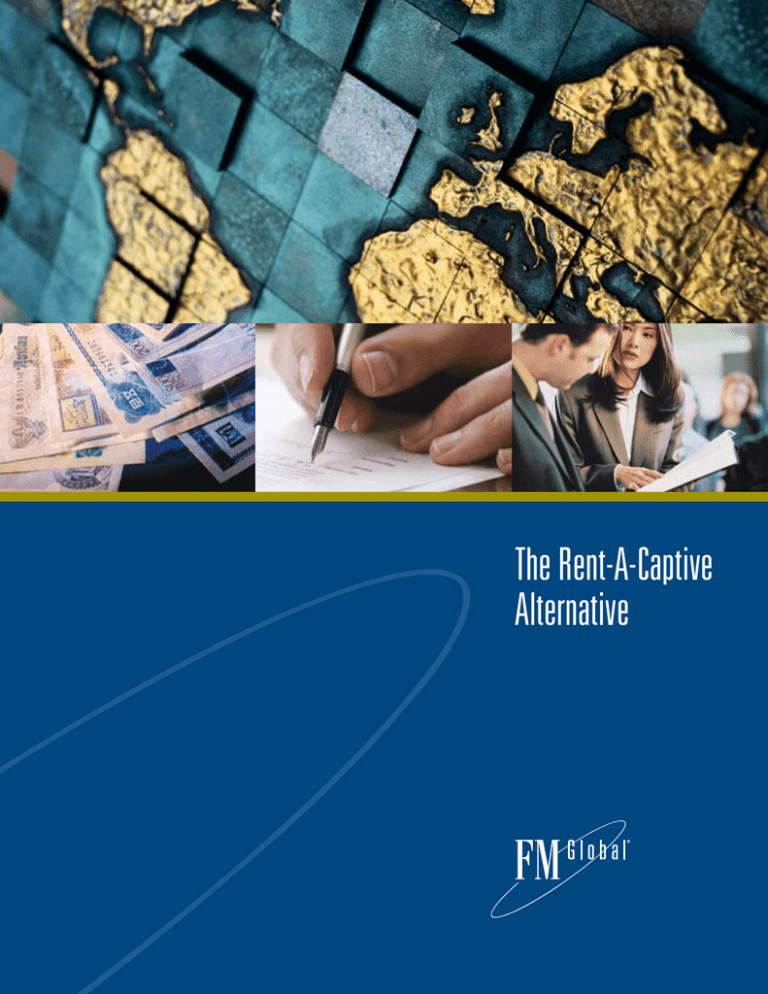
The Rent-A-Captive
Alternative
This brochure is made available for informational purposes only in support of the insurance relationship between FM Global and its clients.
This information does not change or supplement policy terms or conditions. The liability of FM Global is limited to that contained in its insurance policies.
FM Global’s
Rent-A-Captives
at a Glance
Considering the Captive Option
When purchasing insurance, every
business seeks to optimize the point
at which it transfers risk through its
choice of self-insured retention. When
the point is set too low, it can raise
risk-transfer premium, and the business
needlessly trades loss dollars with the
insurance company. When set too high,
it exposes the company to unnecessary
volatility for relatively little savings.
Most companies still use a deductible
as the sole means of controlling selfinsured retention. Sophisticated
companies are turning increasingly
toward captives, which offer a more
formal, flexible and controllable riskretention framework. They are choosing
captives for a variety of reasons—
to share in the profits of favorable
underwriting performance, generate
investment income, fund consistent
deductibles across all locations,
maintain stability of pricing or obtain
broader coverage. As a mutual insurer
focused on the long-term interests of
our clients, FM Global offers policyholders the opportunity to participate
in, and receive the benefits of, a captive
through our established “rent-a-captive”
facilities. These options are available
to our clients through the Watch Hill
Insurance Company, based in Vermont,
USA; and New Providence Mutual
Ltd. (NPML), based in Bermuda
(see sidebar at right).
How a Captive Operates
Although captive insurance companies
have been effective risk management
tools for many years, the word “captive”
can be confusing, and the benefits of a
captive often require some explanation to
determine if a captive is the right choice.
A captive insurer—or simply, a captive,
is a closely held insurance company
whose insurance business is primarily
supplied by and controlled by its owners, and in which the original insureds
are the principal beneficiaries. Like a
traditional insurance company, a captive collects premium, pays losses and
derives investment income. The shareholder-insureds actively participate in
decisions influencing underwriting,
operations and investments.
Watch Hill Insurance Company –
a sponsored, protected-cell
(also known as a segregated cell),
controlled corporation that serves
as FM Global’s onshore option
in North America for alternative
risk transfer. The company was
established in the state of Vermont,
the largest domicile for captive
insurance companies in the United
States, to meet the needs of clients
in North America who want to keep
their financial interests onshore.
New Providence Mutual Ltd.
(NPML) – a segregated-cell,
controlled corporation, based in
Bermuda. Bermuda provides
New Providence Mutual and its
clients with a stable offshore
political environment, along with
an established insurance, reinsurance
and banking infrastructure.
What Are the Advantages
of a Captive?
An organization can realize many
benefits from using a captive as part
of its risk management program.
Significant advantages include
the ability to share in underwriting
profit and investment income. By
utilizing a captive, as opposed to
relying on traditional insurance, the
captive owner essentially retains the
premium paid into the captive, earns
income from the investment of the
funds, and retains potential underwriting profit. In addition, a wellmanaged captive will carefully analyze
its risk exposures, provide loss prevention assistance, monitor claims, and
transfer unwanted risk to reinsurers,
resulting in a lower net cost for insurance.
Is a Captive Right for You?
The Rent-A-Captive Option
The captive option is ideal for many
organizations, but not for all. The prime
candidates generally take a long-term
view toward risk management, have
a strong belief in loss prevention, and
are willing to share in the risk. Also,
the captive option is most attractive
to those clients who can contribute
enough premium to justify the
administrative costs involved. As a
result, well-capitalized companies
often look to captives as a strategic
risk management solution.
A rent-a-captive allows organizations
to obtain the benefits of a captive
insurance company, without the upfront
costs, capital investment and significant
maintenance cost associated with forming
and managing an owned captive.
FM Global’s rent-a-captives are
structured as follows: the client effectively “rents” a protected/segregated
cell, working capital, surplus and
licenses from an FM Global-owned
facility. FM Global also arranges the
necessary administrative, claims,
engineering, reinsurance placement
and admitted fronting services. Under
the segregated/protected cell structure,
there is no pooling of risk between
cells. While Watch Hill Insurance
Company and NPML hold funds for
their insureds, each cell, and its assets,
is legally separated from the others.
As a result, each participant is protected
from another cell owner’s adverse
loss experience.
Once a decision has been made to
consider a captive, the next choice is
simple: Do you establish your own
captive company, or use an existing
facility, such as one of FM Global’s
rent-a-captives?
Choosing to Rent-A-Captive: A Case Study
Participation in a rent-a-captive is a practical and cost-effective alternative in any number of circumstances. The following example
illustrates one of many scenarios that are possible through the negotiation process when designing a rent-a-captive program.
During renewal discussions, a manufacturing company was
seeking a means to continue with the same program and
services already being delivered at the local level, and for the
corporation to benefit from its excellent loss experience. The
company also wanted to pre-fund for future losses. Logically,
the discussion turned to captives, and which type of captive
would suit the company’s objectives. For this mid-sized
organization, the process of forming an owned captive would
be complex and costly. If participating in a group or association captive, the company’s funds might be exposed to the
losses of others. Therefore, the firm decided on a protected
cell rent-a-captive. The next step was to choose one.
It was important that the company retain its current engineering,
fronting and claims services, and that the rent-a-captive be
a fully fronted program with a financially stable insurance
carrier. Following analysis of its finances and risk profile, the
company chose to become a cell owner with New Providence
Mutual Limited (NPML) by retaining the first US$5 million
of annual aggregate losses and expenses above the policy
deductible. To reach the decision on the terms of its program,
several factors were considered. First, the risk management
team was confident in improvements already made to prevent
loss at the company’s facilities. They also had determined
their company could comfortably retain the first US$5 million
(post-deductible) annual aggregate of losses. Moreover, the
program would be easy to administer and be independently
audited every year, and the company would receive quarterly
financial statements detailing the performance of its cell.
Under the agreement, FM Global would credit the premium
for the manufacturer’s US$5 million of additional risk retention, and cede that exposure to the segregated/protected cell
established within the rent-a-captive. The fund benefits by
positive underwriting results plus investment income. Money
in the fund can then be reinvested, used to reduce the letter
of credit, put toward assuming a larger share of risk in future
years, applied toward the reduction of future premium, or
taken back and used elsewhere by the insured.
Rent-A-Captive: How Does It Work?
Launching your rent-a-captive program is as simple as signing a
participation agreement—as contrasted with the many details involved
in establishing a new captive company. The diagram below shows the
flow of funds in a typical rent-a-captive program.
Client
Premium
Policy Issuing Company
Stabilization: Virtually all CEOs, CFOs
and risk managers have seen the volatility
of commercial property premium over
the past several years. The use of a
rent-a-captive is an effective means to
properly structure a program to smooth
the impact of market fluctuations.
Investment Income
and Underwriting Profit
Improved Cash Flow: Because
you are the captive cell owner, both
you and the insurance company
benefit from profitable underwriting.
Rent-A-Captive
Risk Improvement: The captive cell
owner benefits directly from property
loss prevention measures to improve
risk quality at the owner’s locations.
Letter of Credit
Net Ceded Premium
e.g., Factory Mutual Insurance Company/
FM Insurance Company Limited/
Affiliated FM
FM Global’s Rent-A-Captive Advantages
Paid Claims
Loss Payments
Claimants
The insurance transaction with our rent-a-captive works much the same
as that of a traditional insurance program: The client pays premium to the
insurance company. A portion of the premium (an amount determined as part
of the program design) is then ceded as reinsurance to the client’s cell in our
rent-a-captive.
When there is a claim, the policy-issuing company makes the payment, and then
seeks reinsurance reimbursement from the client’s cell in the rent-a-captive.
Ease of Implementation: Fully
established and professionally managed,
our rent-a-captive program offers you
instant access to an operating company,
which means reduced capital requirements
and minimal administrative burden.
Also, our rent-a-captive option provides
one-stop access to all property insurance
services, including fronting, with easy
entry and exit provisions, from a stable,
financially secure provider.
Flexibility: While the rent-a-captive
approach does not fit every situation,
the professionals at FM Global have
the ability to help assess whether a
program can be designed to best meet
your organization’s insurance needs
and serve its long-term interests.
Your FM Global client servicing team
representative can help you determine
whether a rent-a-captive might be the right
option for your risk management program.
P0561 Printed in USA (12/05)
© 2005 Factory Mutual Insurance Company
All rights reserved.
www.fmglobal.com
In the United Kingdom:
FM Insurance Company Limited,
1 Windsor Dials, Windsor, Berkshire, SL4 1RS
Regulated by the Financial Services Authority.


